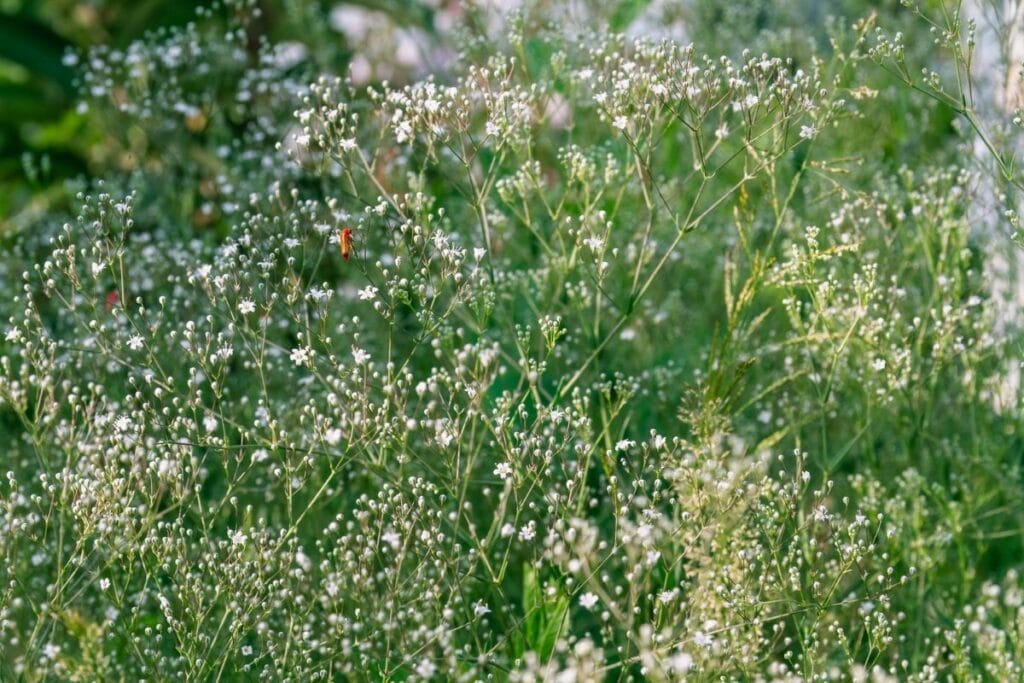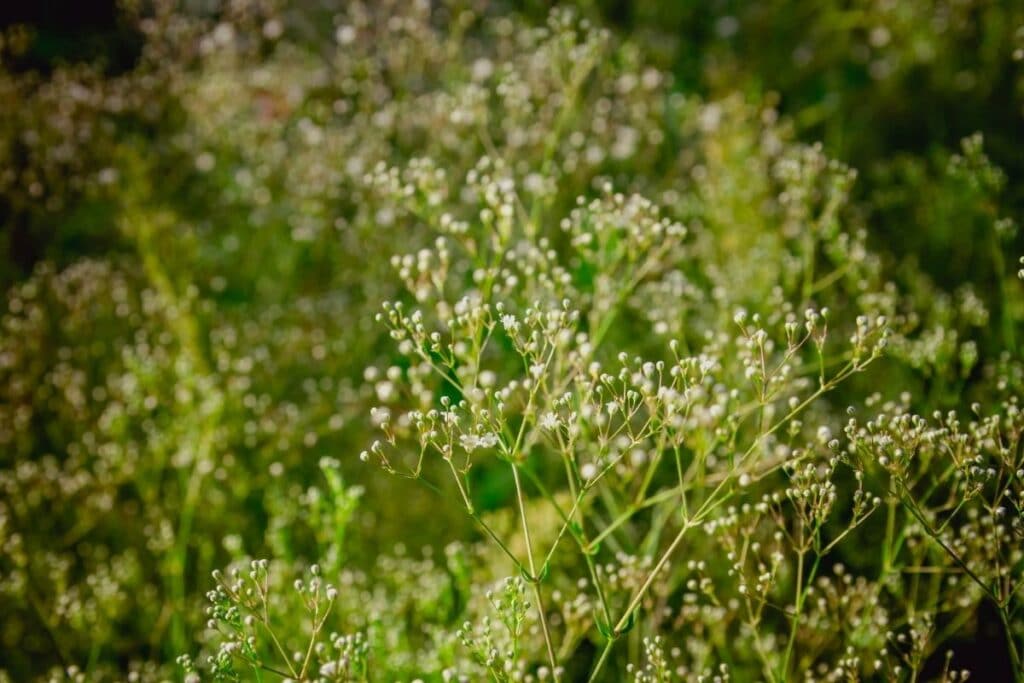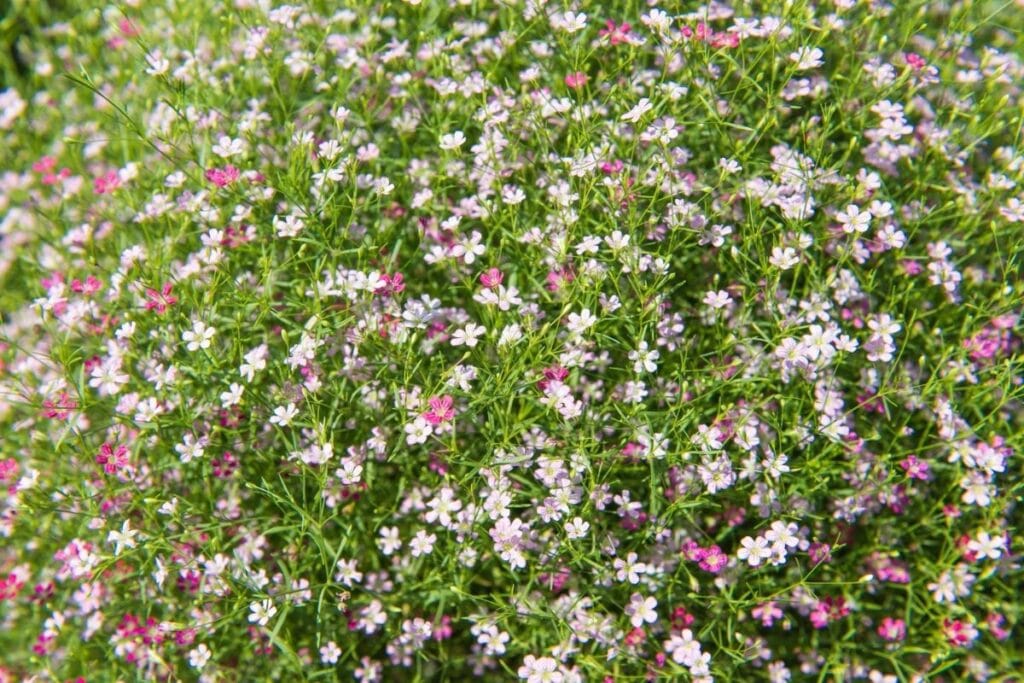Baby’s breath is a flower that symbolizes innocence and purity. It can also be used to signify love for someone special in your life.
The flowers are often given as an expression of friendship or as a gift to say “thank you”.
Baby’s breath, Gypsophila, can be difficult to grow so it is not recommended for beginners, but when they do grow, they have a long blooming period from May through October – and you’ll be rewarded with a fragile, delicate beauty that’s sure to take your breath away.
Here are some tips on how to grow baby’s breath plants in your backyard garden.
What is a Baby’s Breath Plant?
It might sound delicate, but once established, the baby’s breath is quite easy to grow. The trick is in getting it established! This plant is often used in floral arrangements such as wedding centerpieces, wreaths, and bouquets.
A member of the Gypsophila genus, baby’s breath is one of the largest groups in the carnation family known as Caryophyllea, which contains 150 species of perennial and annual plants. The genus name is derived from the Greek word “gypsos,” which means “gypsum,” and “philios,” which means “loving,” a reference to the gypsum-rich substrates on which many of these species grow.
Most baby’s breath species that we know of are cultivated commercially for floristry. However, some are even cultivated for food and herbal medicine! This article will deal primarily with the type of baby’s breath used in floral arrangements, which is known as common gypsophila or Gypsophila paniculata.
Baby’s breath flowers are small, with each only about the size of a pencil eraser. However, each plant will produce hundreds of blooms, giving the plant a truly breathtaking appearance. Normally grown as an annual baby’s breath, but can be grown as perennial plants in some climates.
Growing Baby’s Breath
This flower should be planted in the late spring or early summer after the last expected frost date in your area. This is true regardless of the method in which you are planting your baby’s breath, be it from cuttings, seeds, or established plants.
The good news is that, in many places, the plant is perennial, so you can plant it once and enjoy it for many years to come.
Do be mindful of where you plant your seeds. In some states, it is an invasive wildflower or noxious weed because it spreads so rapidly. It can easily outcompete other plants for space and nutrients so it’s important to check with your state’s guidelines to make sure it is safe to plant before you do so.
Baby’s breath prefers full sunlight so you will want to choose a location where your plant can get six hours of direct sunlight per day. The soil should be well-draining and a bit sandy with lots of organic matter. Alkaline soil is preferred, generally with a pH between 7.0 to 7.5.

How to Plant Baby’s Breath
Although you can plant these perennial baby’s breath from cuttings or starting transplants, the easiest way to grow this plant is from seed.
After selecting the ideal planting site, sow seeds by sprinkling them across the flower bed. Press down lightly to embed the seeds into the soil or sprinkle a light layer of soil on top of the seeds.
Keep the soil moist as your seeds germinate – it should take less than two weeks for them to do so. Once the seedlings are about two inches tall, you should thin them back so that they are 12 inches apart.
You’ll follow the same tips for planting baby’s breath from a transplant, choosing a spot that receives six hours of sunlight per day. Plant your sprouted plants in a hole just a few inches wider and deeper than the existing root ball, then backfill with soil and a bit of compost, if you’d like. You may find that you need to stake your transplants to help the stems stay upright while the roots are establishing themselves.

Baby’s Breath Care Guide
Once your flowers are planted, don’t be fooled into thinking your work is done! There are a few more things you will need to do in order to ensure the health and vitality of your plants.
Watering
The good news about growing these plants is that they are remarkably drought-tolerant once it is established. It can handle dry spells with ease. Just moisten the soil once per week or so.
In fact, overwatering is the easiest way to kill your baby’s breath plant, so don’t be too heavy-handed with the watering can. If you can, water at the base or install a drip irrigation system so that the branches and flowers of your plant don’t get too wet. On average, this plant needs less than an inch or so of moisture per week.
Fertilizing
You can fertilize once per month during the growing season. Use an all-purpose fertilizer that has equal amounts of potassium, phosphorus, and nitrogen. A 10-10-10 will work just fine, as will an aged compost. Be cautious not to apply too much fertilizer, as it can harm the plants.
You can also amend the soil prior to planting, if you choose. Adding just a bit of compost to your planting hole will ensure that your plants are healthy and grow well throughout the season.
Pests and Diseases
There are two diseases to which a plant like this is prone – rot and blight.
Rot typically appears as either crown or stem rot. These two diseases are typically caused by soilborne pathogens that result from poor garden maintenance or poorly draining soils. It can cause a yellowing of leaves or collapse the entire plant.
If you don’t act quickly, rot can decimate all of your plants. Proper irrigation is essential to preventing this disease and while you may be able to use a fungicide to control rot, it’s far easier to prevent this disease than it is to treat it.
Blight generally appears as a black, dark rot on the flowers of the plant. You might also see dark spots appearing along the stem. Unfortunately, this disease spreads quickly among the plants, so it’s important to act quickly. You can usually prevent this disease by avoiding overhead watering. Any plant materials infected with blight should be destroyed as soon as possible.
There are also a few insect pests that feed on baby’s breath. One common baby’s breath pest is the leafhopper. Adult leafhoppers are green-yellow bugs that have black spots, though nymphs will be smaller and lighter in color. They can spread aster yellows, another common baby’s breath disease. The first sign of damage from leafhoppers is usually a small white or yellow spot on the plant’s foliage, but these leaves will then fall from the plant.
You can prevent leafhoppers from damaging your plants by covering your plants with row covers in the spring. Neem oil can also be used to control the populations of these pests.

Other Tips for Growing Gypsophila
Besides watering and weeding, there are very few things you will need to do to care for your plants.
Staking is essential as the plants get larger. Some cultivars can grow to more than four feet tall so you might want to insert thin bamboo shoots near the roots and fashion the plants to your stakes with a loop of twine. This is necessary if you find your plants’ branches are leaning to one side.
You may also need to prune every now and then. Though deadheading is not required, regular pruning can help your flowers look their best, particularly if you are growing perennial types of this plant. To overwinter your plants, just cut the plant back after the last bloom and then cover it with mulch. This will help it withstand the harsh winter weather with ease.
Overwatering is perhaps one of the most common ways that people accidentally kill their plants, especially if the plant isn’t getting enough sun or airflow. The soil should also only be moist when squeezed between your fingers; don’t water until the top layer starts to dry out completely. Be sure to fertilize with compost at least twice per month during spring and summer months, then once every two weeks until September or October.
Common Types and Varieties of Baby’s Breath
Gypsophila paniculata is the most common type of baby’s breath grown by home gardeners. Also known as common gypsophila and panicled baby’s breath, this flowering plant is native to eastern and central Europe. A herbaceous perennial, it can grow up to four feet tall and wide and produces gorgeous mounds of branching stems with tiny, puffy white flowers.
It grows well in poor soils, known to inhabit stony, dry, and sandy places. It prefers alkaline to neutral soil and grows well in full sun.
Within this species, there are several popular varieties that you need to know about as a gardener.
Bristol Fairy
Bristol Fairy is one of the tallest variety of baby’s breath you can grow, often reaching heights of four feet. It produces flowers that are white and delicate, only about a quarter of an inch in diameter.
Perfekta
Perfekta is one of the most popular perennial varieties of baby’s breath. It grows up to three feet tall with flowers that are slightly larger than those of other varieties, typically measuring about half an inch in diameter.
Compacta Plena
This variety is a bright white cultivar that can grow up to two feet tall. It’s often grown for its flowers that can be edged with a light pink coloring.
Viette’s Dwarf
Viette’s Dwarf is one of the most unusual varieties of baby’s breath, producing pale pink flowers. It only grows to about 15 inches tall at the most and has flowers that bloom on a compact plant in the spring and summer months.
Pink Fairy
Pink Fairy is another dwarf cultivar to consider growing. This plant blooms much later than other varieties and only grows to about 18 inches. This makes it the ideal specimen for containers!
Gypsophila Repens
Gypsophila repens, commonly known as Creeping Gypsophila, is a low-lying and cushion-forming variety of baby’s breath. It features gray-green foliage and produces small, white, star-shaped flowers. With its creeping growth habit, it thrives in zones 4-9 and looks charming at the front of cottage-style borders or growing along stone walls
Festival Star
Last but not least is Festival Star. This plant grows to around 18 inches and has the classic white blooms that you’ve likely grown to expect with this flower. It is a hardy variety that can be grown in USDA zones 3-9, with a cold tolerance that is virtually unheard of with this plant.
FAQs
Is baby’s breath easy to grow?
Yes, Baby’s breath (Gypsophila) is relatively easy to grow, as it is tolerant of various soil types and climates. It thrives in full sun and well-draining soil.
Does baby’s breath need to be in water?
No, Baby’s breath does not need to be in water to grow in the garden. However, when used in floral arrangements, it should be placed in water to maintain freshness and prolong its vase life.
Is baby’s breath an indoor plant?
No, Baby’s breath is typically grown outdoors in flower gardens or flower beds but can also be used as a cut flower in floral arrangements indoors.
How long will baby’s breath last?
Baby’s breath can last for around 5-14 days in a vase when properly cared for, depending on factors such as temperature, humidity, and the freshness of the healthy stems.
How long will baby’s breath last without water?
Baby’s breath can last for several hours without water when used in flower bouquets. However, to maintain its freshness and appearance, it’s best to place the stems in water as soon as possible.
Conclusion
In conclusion, baby’s breath flowers, with their delicate appearance and long-lasting blooms, are a charming addition to gardens and bouquets alike. By following these simple baby’s breath flower care tips, you can ensure these tiny flowers thrive and bring a touch of elegance to your space.
Up next: Baby’s Breath Flower Meaning and Symbolism
*image by OlgaMirMir/depositphotos






